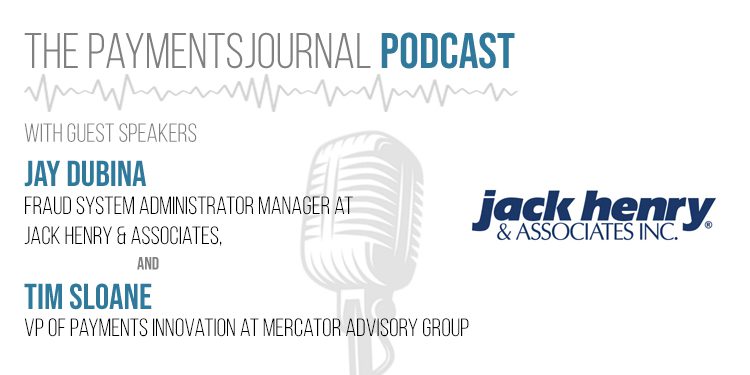Podcast: Play in new window | Download
Consumer behaviors within the payments ecosystem seem to be in a constant state of flux. Technological advancements, geopolitical and epidemiological pressures, and evolving payments preferences create an atmosphere of progress and uncertainty. Thankfully, there are experts with an informed view of what the future holds. One thing that remains clear is that wherever the payments industry goes, fraud will follow.
To learn more about the future of payments and the concurrent future of fraud prevention, PaymentsJournal sat down with Jay Dubina, Fraud System Administrator Manager at Jack Henry & Associates, and Tim Sloane, VP of Payments Innovation at Mercator Advisory Group.
The state of cash and checks
The Onbe 2022 Future of Payments Survey showed that 32% of individuals are planning on using cash or checks less or not at all in 2022, and that percentage jumps to 37% for 18-24-year-olds. “Can you believe it’s 2022 and we still have checks that are out there?” asked Dubina. “From a fraud standpoint, there’s nothing that says secure like, I’m going to have my routing number and account number in the clear on something I’m going to hand to a complete stranger.”
Society has been clinging to the outdated and unsecure payment system of checks for too long. “Cash, on the other hand, you’ll never get away from,” offered Dubina. “There are always going to be people that are unbanked or underbanked that really need that cash.” Granted, cash use is still decreasing, for several reasons that all dovetailed with the COVID-19 pandemic: everybody became fearful of viral transmission via surfaces; there was a coin shortage; people got more comfortable with electronic payments and noticed how easy, fast, and secure they are.
Payment methods wax and wane over the course of a long and perhaps unending cycle. “No payment network ever goes away,” Sloane pointed out. “They simply start to get displaced. Volume goes down, but they never go away.” Meanwhile, new payment methods crop up alongside the old ones, and we are left in fraud limbo: fraudsters have free reign with the older and less safe methods, like checks, and also take advantage of the new and lesser understood digital methods, like crypto or P2P. “How many times do we see marketing ahead of security when it comes to locking something down?” noted Dubina. “The older payments are still there. There is still fraud on them.”
Businesses are playing catch-up with consumers
Digital payments are taking hold, no doubt about it. But are businesses keeping up with the trend? “Businesses have always been just following what the consumers are presenting,” Dubina explained. “If consumers are presenting cash, then we want cash – whatever to make the consumers happy.” Newer payment methods, such as Apple Pay, saw slow adoption across the business world, and the explanation is simple: Apple Pay didn’t exist until it did. Initially, consumers had access on their smartphones, but hardly any businesses were prepared to accept it.
The COVID-19 pandemic has been the major catalyst for recent changes. “Contactless cards, since the pandemic, have just gone through the roof,” said Dubina. Again, the reason was threefold: people wanted to pursue the safest option health-wise; celebrities and advertisements trumpeted the new methods; and once usage picked up steam, people saw value in the security and convenience that contactless offers. Compared with even just a couple of years ago, it is fully outside the norm for merchants to not accept contactless at this point.
Merchant size and category is a major determinant of accepted payment methods. “Restaurants had to go to order ahead for pickup, and so if they were only accepting cash, surprise! Now you better move to a card,” said Sloane. Larger merchants could also afford to make the shift because they had the capital to invest in new payment types early. Regardless of the reasons behind digital payment acceptance, it is all about giving the consumer a frictionless payment experience that makes purchases easier.
Bridging generation gaps and looking towards the future
Dubina noticed two interesting generational payments trends. “Older generations all of a sudden had to adopt more electronic payments,” explained Dubina. At first, older folks tend to be more set in their ways and comfortable with traditional payment methods, but once they see the ease and security of digital payments, many are happy to stick with it, and even wonder why they didn’t start earlier.
Meanwhile, in the younger generation, the explosion of Buy Now, Pay Later payment options have led to a whole new avenue for fraud. “It becomes a big problem in the fraud world, trying to identify all these Buy Now, Pay Later transactions,” Dubina clarified, “but the younger generation loves them.” Additionally, when young folks flock towards P2P apps, it drives parent adoption as well – after all, kids need spending money. “Once you’ve done it, you see how easy it is,” said Sloane. “Yet there is more fraud enabled by that P2P environment than most people should be comfortable with.”
Still, secure transactions are receiving heavy attention, with strong card-present technologies like EMV chips for debit and credit cards, and online authentication systems like 3-D Secure, which has evolved from its frustrating rollout to become a truly phenomenal system. Bringing the online and in-person worlds together requires a serious digital literacy campaign to ensure the human element of payments is not the weak link.
“There needs to be more education around payments, around social engineering of people,” concluded Dubina. “We see people all too willing on their social media profile, which is very likely not locked down, to answer surveys that give out all of their security information… I think there has got to be more education as far as what information they should and should not be giving out… Otherwise, we’re going to start seeing a lot more broad account takeover types of fraud.”










